HAT Togo - Morocco 2017
In the spring of 2017, I, Ingrid, have a trip with Holland Africa Tour (HAT) made from Togo to Morocco with MAN KAT 1 trucks. Unfortunately, Onno was unable to get free from work for this four-week adventure. But luckily he was able to ride 'digitally' and even helped us from a distance when we were lost in the Sahel.
But first the most important thing, what is Holland Africa Tour? This is a foundation under the inspiring leadership of Loek and Jim Vermeulen (the racing twins), who have extensive experience in desert travel with trucks, off-road vehicles and motorcycles. During their travels, they visit villages in Africa where relief supplies such as flour, clothing, school materials, medicines and toys are distributed. In addition to sponsorship, part of the financing is provided by the people who travel on the trucks. This creates a fantastic combination of help and fun. For more information, visit the website of Holland Africa Tour (HAT).
Lomé - Golden Eye
18 March 2017: 170 km
Thanks to Royal Air Maroc, which canceled the flight from Casablanca to Lome on Friday night, the group was split in two. Jim, Eri, Gerd, Kees, Edwin arrived early Thursday morning to pick up the trucks at Heavy Mat, the company of Denis Rozand, where the trucks were parked. The first Crew worked all day to get all the trucks back in order. The trucks were filled with 2350 liters of water and 6000 liters of diesel. Yolanda, Fer, Gerrit, Abbie and Ingrid arrived on early Saturday morning with extra suitcases with provisions for the coming weeks. After a delicious breakfast on the terrace with a sea view, we left for Golden Eye. The first encounter with Togo was complete, the busy cities, the villages in which the children waved us in and the beautiful nature in the direction of Golden Eye where we camped for the first time. Eri had prepared the food with something for everyone. After this long day, everyone visited the roof tents on time.
Golden Eye - Lama Tessi
19 March 2017 - 230 km
The morning starts with a view over the valley in mists filled by the high humidity. After breakfast in the relative coolness, the necessary repairs are made to the MANs. conducted. Kees replaced a fuel line and the MAN 8 canvas was repaired by Fer and Ingrid with needle and thread. The MAN 6 has problems with the coupling, time to fix it is not today. For the time being, Gerd regularly replenishes the liquid in the reservoir. After a nice drive through the hills, the first fellow travelers got the chance to drive the MAN 8. The first principles of shifting, taking up space when overtaking, steering in a large turn and braking in time were patiently taught by Fer. After a full day of driving it is time to find a good place to sleep. The N1 road has attracted many villages, leaving the sought after quiet camping spot. Just before dark a hotel is found with a small courtyard where the trucks can stand. The MAN 6 maneuvers as effectively as possible without a working coupling between a narrow passage of a concrete railing and the gutter. We consider that only the roof gutter was damaged as a good performance. The menu was a choice of chicken with rice or spaghetti or couscous. The organic chicken had probably been so mobile that the stiff meat could hardly be pulled off the bone. We go into the night with rain that barely cools down.
Lama Tessi - Dapaong
20 March 2017 - 260 km
After breakfast at the hotel, the men 's driving skills are called upon to get the trucks out of the small courtyard unscathed. In a village, Eri manages to store cans of fresh and, even more importantly, beer. Yolanda has selected a beautiful route. The rural life unfolds, we see the first round mud huts that characterize Africa.
The N1 merges with the N17, which over time turns out to be no more than a very narrow goat's path on which we try to dodge the trees through the sand and in a constant slalom. For the student drivers a nice introduction to off road driving. Doubts about the correctness of the route strike the fellow travelers, but Yolanda insists that this is the correct route. Yolanda gets her right as soon as we see the asphalted road again; no one doubts her word anymore.
Dapaong
21 March 2017 - 0 km
In the early morning, while some still slept wonderfully in the roof tent, the go-geters were busy with the work early on. Everything that has broken down over time, Kees is bothering each other again. The MAN 8 is cleared and cleaned by Fer, Jim and Abbie in search of a link. Gerrit patiently repairs all storage compartments in the MAN 6, Gerd and Edwin take on various repairs.
Yolanda delves into the instructions for use of the MIFI box and with the right maps in Burkino Faso the internet possibilities look promising. At 14.30 o'clock the cautious conclusion sounds that the MAN 6 has a working clutch again. Today the border crossing to Burkino Faso was planned. After consultation it is decided not to visit the planned border crossing in the afternoon due to the expected long lines and to ensure that we are the first the next morning.
Dapaong - Ouagadougou
22 March 2017 - 320 km
At 6.45 hour we leave for the Burkina Faso border. Today Abbie is the last to be baptized as an apprentice truck driver. After barely a kilometer, we are taken away by the tough-dressed police officers. Checking driving licenses and wearing seat belts. We look forward to the driving license check with confidence because Jim happened to have stamped the international driving licenses last night. We are less fortunate when it comes to wearing the seat belts, none of which we wear. The crew of the MAN 8 has to account for itself while the rest of the group in the other trucks is eagerly looking for the belts. Thick in the dust behind the seats, the belts are sought for the right seats. It was to no avail, all three drivers must each pay an 10.000 CFA fine. Fer and Yolanda manage to buy it off for a total of 10.000 CFA, although without a receipt. The border crossing to Burkino Faso is African chaotic. While we wait for the passports, we can change the first flat tire. The reception in Burkino Faso is warm, the procedures inscrutable. We miss the first of many police and customs posts, which is evident when we are stopped by a soldier on the motorcycle. We set sail again to arrive before dark, but a flat tire still awaits us. In 43 degrees of warmth, this band is changed efficiently by good teamwork. It is already an hour dark when we reach our sleeping place in the capital Ouagadoudou.
Ouagadoudou
23 March 2017 - 0 km
Today a rest day. Everyone slept well in the rented hotel rooms with air conditioning. Jim, Fer, Yolanda and Ingrid take a taxi to the supermarket to replenish the stock with more than 100 cans of soda, which are eagerly drunk chilled every day. Edwin and Gerrit ensure that the tires are repaired. Fer did not come undone yesterday when replacing the clutch. He finds a sewing workshop to have his trousers, which have since been completely torn from top to bottom, repaired. The swimming pool at the hotel provides a welcome cooling and ensures a relaxed afternoon. Yolanda knows from previous visits to the city a good restaurant where we will eat tonight.
Ouagadoudou - Karekuy
24 March 2017 - 308 km
We leave Ouagadoudou early because we want to end up close to the border in the afternoon. It takes some time before we leave the big city. The people in the countryside are very friendly, everyone waves to the trucks.
We stop for lunch close to a settlement with a well. The children show up everywhere and find the trucks really interesting. They gather under a tree and look with interest at our activities. It does not look like these children go to school. Eri hands out Snel Jelles that the children receive in grateful embarrassment.
Jim has planned a refueling in the last town we encounter. The service level of the gas station appears to be high, a pump operator immediately releases two pumps for the trucks. When filling up the extra tank inside the MAN6, an employee tries to make it clear to us that cooking soup on gas and refueling in the same interior space is not wise, we are grateful for his attentiveness. An old employee without teeth and with an overdose of self-confidence declares the love of every woman in our company and is soon ready to write down her telephone number with pen and notepad. A friendly employee prevents Ingrid from taking the shopping basket to Morocco. We cover the last kilometers and stop 70 kilometers before the border to make camp in the middle of nature, the first time during the trip. The whole village walks out to see us. Jim lays down a rope like an imaginary boundary, no one steps over it. When it gets dark, people disappear to their huts and we have our privacy back.
Karekuy - 30km west of Bla
25 March 2017 - 276 km
After coffee we drive away at 7.00, enthusiastically waved goodbye by the villagers. The road to the border with Mali is quiet, we hardly encounter oncoming traffic. Border procedures in Mali take the necessary time. We have to wait a while for the arrival of the border manager who turns on the electricity, after which the officers can fill in the forms for the trucks. In the meantime we drink coffee with the employees under a tree. The football that Yolanda gives to passing children is confiscated by a border official. We understand later for his son. That the officials are used to receiving gifts is clearly stated to us, if we do not offer it ourselves, they will be asked directly. Two and a half hours later we are allowed to drive on, with the stamps in our passport. In Mali the inhabitants are more reserved than in Burkino Faso. They look at the trucks in surprise and do not wave back automatically. We choose an 90 kilometer long dirt road with the aim of finding a quiet place for the night. After a trip over the fields, we end up on a nice flat part right next to the road. We are now trained in making camp, everyone picks up the necessary chores and a cold beer awaits us.
Near Bla - Bamako
26 March 2017 - 235 km
We get up at 6.00 o'clock and continue the dirt road one hour later. The further the road of civilization goes, the more marvelous it goes. The road we drive does not match the route on Galileo. Houses have been built on the site of the original road and around these houses a maze of roads has been created. Yolanda knows how to choose the right path every time. We can practice our off-road skills on the road with constantly new challenges for the trucks. Occasionally we jam the cars because the road does not follow, we get stuck under the trees and we try to avoid large pits. We can tell from the surprised faces of the residents that little truck is driving here. Waving to the Malians, only adults respond. We soon learn that we not only have to wave but also laugh out loud to break the ice of the children.
A broad river unfolds before us out of nothing. A loaded bus has just hit the ferry, the men hardly get the ferry moving. Jim investigates and hears that the bottom of the river is no problem for the trucks. We decide to drive the trucks through the river, the apprentice drivers are happy to leave this job to the fellow travelers with a large driver's license. After responding for miles, steering well and braking, we reach the main road, the cold soda tastes extra delicious during the inserted stop. On our way to, the luxury resort by Malian standards, the final challenge awaits us. The electricity cables are hanging too low to give the trucks a safe passage. Gerd finds a long branch with which the cable can be pushed up and Edwin climbs on top of the MAN 6 to guide the cable over the highest point. We finally reach the resort that looks promising for the day of rest tomorrow with three swimming pools. Although, at 22.30, Jim still has a list of work for the relatively cool morning hours.
Bamako
March 27 2017
Most people are awake at 6.00 hours and start work immediately. A temperature of 42 degrees is again expected today. Around 10 hours Lex and Els are warmly welcomed by the group, they arrived in Mali that night and have some hours of sleep. Lex brings the bag with parts and tools for the trucks. The coveted hinges for attaching the road plates are not in the bag to the disappointment of Jim and Kees. They find a different solution creatively.
While the men do odd jobs, Eri makes a delicious sauce for dinner. Jim draws up a shopping list to supplement inventory. The list is not long, unlike the duration of the taxi ride. We have to visit a different store for each product, the driver has an address for everything, including the coffee to-go. Stocking up on a drink is at the top of the list. The trunk of the taxi is so full that even the lowest threshold abolishes the bottom of the car. It does not seem to bother the driver, he drives on undisturbed. When they return home, Yolanda and Ingrid make a lunch of the fresh eggs and baguette, which after the hard work is in great demand.
In the afternoon everyone is looking for a cool dip at the swimming pool. Those who have left their swimming gear at home jump into the pool in their underwear.
Bamako - just before Mansala
28 March 2017 - 197 km
The loudspeakers for the Islamic prayer service wake us up at 5.30 hour, the service starts with loud singing and turns into a long sermon, or so it sounds. We are ready to leave the campsite on time. Because of the large, high trucks in combination with trees that block the way out, it takes a while before we are on the street. Then the real challenge begins: leaving Bamako. For this one has to cross one of the three bridges over the river Niger, we have been warned that this causes a lot of traffic jams. It took two hours before we finally reached the main road. This time the entire route goes over the asphalt road, only one road leads to the next destination. The many and sometimes high speed bumps are the driving challenge for the rest of the day. We see cars and less fortunate drivers crashed along the road. For some of us, the persistent warmth of now 45 degrees in the shade is still a day of survival. Almost nobody gets the required amount of 6 liters per day, the advantage is that we do not lose time on the road with pee stops.
We find a nice overnight place along the road relatively late. Everyone is tired, more than a pancake is no longer used by most. Jim is satisfied, a lot has been repaired yesterday and today hardly any defects have been added to the trucks. We drink that before we visit the roof tents.
Near Mansala - Manantaly
29 March 2017 - 133 km
We continue on the road after we have eaten the rest of the pancakes. After 30 kilometers we turn on an off road road. We pass villages where we hand out the caps that Lex and Els have brought. Kees stops at a village to give away a football. In a few minutes there are a hundred people around us who all want to shake hands first. Kees gives the ball to the village elder, after which the football game starts immediately.
We reach the campsite of Casper Jansen on the river Bafing around noon. The 1000 kilo fertilizer brought for Casper's banana tree plantation is unloaded, he expects to be able to double the harvest. After eating a fresh fruit salad it is only a matter of minutes before everyone dives into the river. In addition to the banana trees, Casper also has many mango trees and shrubs with cashew nuts. A single nut grows on every fruit the size of a lemon and contains almost as much juice. The process of harvesting and burning the nuts has many steps, we now understand why these nuts are pricey.
Manantaly
March 30 2017
As on every 'rest day', the men start work on the trucks early. Now that there are no urgent repairs, the men start looking for the answer as to why the MAN 6 loses air when shifting and braking. At the agreed time Casper is ready to drive us to the villages where we will repair the water pumps. We climb into the cargo area of the Toyota Hilux and feel like real Africans. In the first village we are received exuberantly by the residents; the women dance, drum and sing enthusiastically. The pump that takes the water from the river to the arable farm no longer works, one has to do without water for several days. Edwin and Kees soon realized why the pump is not working, after half an hour we hear the diesel engine running again. In gratitude we are taken to the square where the village elder lives, where we are offered a living goat, which they want to slaughter for us. After some time negotiating and convincing, we managed to save the life of the goat.
In the next village we are received less enthusiastically. When we see the pump, we understand why, it still brings water up. We carry out major maintenance and lift 4 × 7 meters of pipe, after which the head of the pump can be replaced. This guarantees that the pump continues to supply the village with water. When on the way back the battery in Casper's car breaks down for the fourth time and we all have to push the car back on, we yearn for the cool river and cold beer.
In the late afternoon we drive to the dam, where we can see the interior spaces of the impressive turbines.
Manantaly
March 31 2017
The guide in Mauritania made a mistake, and expects and picks us up one day later at the border. We decide to stay another day at Casper, the cool river binds us to this campsite. The men carefully repair the flat (inner) tires. Yolanda and Ingrid make pasta from the fresh vegetables they have bought together with Casper, a fried banana in the sauce is the local culinary tip. We make Casper happy with the old supply of food that has been removed from the MAN 8.
The men return to the water pump armed with new oil and various nuts. On the way back they want to bring groceries, but the Friday afternoon prayer ensures that the village is abandoned and the shops closed. Kees and Jim replace the brake booster which gives the MAN 6 more air. After dinner, Gerd and Abbie start a good mood with the large mountain of dishes of the whole day.
Manataliy- north of Ossoubidiania
1 April 2017: 191 km
Casper waves us goodbye and we continue our journey through Mali. A beautiful off road leads us to the river where we take the local ferry. The ferry is not large and five trucks are still ahead of us. Jim throws his charms and 5.000 CFAs into the fight and manages to put us in the queue. Passenger cars still know how to force progress, which means that only the MAN 8 can take the ferry. While the ferry sails away, Gerrit discovers a flat tire at the MAN 4, despite all repair efforts the day before, we write off the tire.
The ferry is back with a long, heavily loaded truck that drives off the ferry and gets stuck on the ramps. The MAN 6 makes various attempts to pull the truck forward, which ultimately works. We can ride the ferry and join the MAN 8.
Ossoubidiania - Nioro du Sahel
2 April 2017: 181 km
We start the day with a 'white' country road that Yolanda has found on the map. Around noon we reach the main road and we can choose from a 'pink' country road (Michelin) or an asphalt road. We choose the country road in expectation to reach the last city in Mali around 17.00 hours. Although we have the impression that we are driving well, we reach an average speed of 12 km / hour. We arrive in the town at 18.15 and use the possibility of refueling for Mauritania. The only hotel is too unattractive to use the night. The police offer us two options for overnight accommodation: on the grounds of the police station or at the border 65 kilometers away. Under the guidance of the police, we are guided through the city to the office. We make the camp next to the police station, their toilet and shower is offered hospitably. Kees needed a lot of words to carefully describe the condition of the sanitary facilities at the police station. A personal look at the 'bathroom' led to the conclusion that the crane at the trucks and a place in nature can be described as luxury. Three tough armed officers watch over the trucks while we go to sleep in the roof tent.
Nioro du Sahel - 60 km for Timbedra
3 April 2017: 174 km
We are approaching Mauritania, the landscape has the appearance of a desert and we see the first dromedary. The population in Mauritania is almost entirely Muslim, at the border the officials only welcome the men from our group with a handshake. Although Mauritania is one of the poorest countries in Africa, the border and visa procedures are not inferior to a Western country. The passport is read in and scanned, the fingerprints and a digital passport photo are taken, then a color visa with the passport photo is printed and pasted into the passport. It is not clear which personal information about us is included in the Mauritania database because the English-language error messages are consistently and persistently clicked away. Then we must report to the police, where again fingerprints and passport photos are made.
To our relief, nobody is present at Customs, the large amount of alcohol that we have with us enters the country unseen.
We are met by the soldiers who must protect us during this trip. Tourists were raided in this part of Mauritania in the past or worse, and as a result Mauritania received a negative travel advice from the European Union.
The accompanying soldiers ensure that the tourists pass safely through the parts with code red (advice: do not travel). The security concerns no less than four Toyotas with a total of 18 soldiers and six goats who guard us with a point 50 machine gun on the roof and the well-known Kalashnikovs. The equipment is complete with helmet and protective vest at more than 40 degrees Celcius.
There is some confusion about the provision of information about the exact route that we have to drive. The soldiers expect to get way-points from the route and our guide has never been to this area before. Eventually two Toyotas are leading the way because the soldiers are in possession of staff maps and an advanced GPS.
The drivers of the MANs are struggling between keeping speed, which is what the captain calls us to, and the trucks are driving unscathed through the trees. When making the camp, it becomes clear that neither was successful: we did not reach the destination and the trucks were damaged, from broken rear-view mirrors to losing the roof of the MAN 4.
The Toyotas of the soldiers line up in the four wind directions a few meters from our trucks. Our privacy is over, even unseen 'visiting the toilet' in bare nature is no longer possible. The soldiers prepare the dinner, the goat turns out to be the meal that is prepared over the campfire.
Babij Timbedra - 40 km above Nema
4 April 2017: 270 km
Again, the asphalt roads are so narrow that hardly two trucks can fit. In all countries we travel through, it is important to keep driving with the left-hand wheels on the center line so that the right-hand wheels keep a safe distance from the tire-destroying asphalt edges, until the oncoming car leaves room. In Mauritania, even the widest and most heavily loaded trucks disappear prematurely on the roadside. Seeing the armed terrain cars with soldiers is probably intimidating enough to make way for our approaching column.
The speed of the first day is out with the soldiers, they stop in Nema while we go shopping at the local supermarket, the Toyotas go to the army base one by one to refuel. All in all we are waiting for four hours.
As soon as all Toyotas are back, we expect to make meters. Nothing could be further from the truth, because prayer must be stopped soon.
Jim and Eri have drawn a nice route on the map; we want to follow the track that can be seen on the map in a thin black line from Nema to Tichitt. The soldiers have asked locals to guide us to the start of the right track. As soon as the local leaves us, the soldiers immediately lose track. The soldiers appear to be approaching the level of our boy scouts in this area. To our surprise, they often deviate from the right wind region.
At dinner we decide to take a different approach. If we have the waypoints ourselves, we are less dependent on the military, is the reasoning. With the satellite phone, Ingrid calls her husband Onno, who texts the waypoints on the route. The men repair two tires and new tires are removed from the MAN 8. We are ready for the Sahel terrain.
Near Nema - 90 km NE from Ouadane
5 April 2017: 200 km
In good spirits, we are on the road at 7.00 in possession of way points. We hope to catch up this day. If there is a clear black line on the map, recognizing this track in the endless sand plain is something completely different. There are no old traces visible that make clear how the path runs. In the Mauritania desert, a way point on the track from 'an unmissable beacon' is demoted to 'an indication of the route'. After the soldiers have asked the locals for the route, we reach a camel camp where many water sources provide the camels, sheep and goats with water. One of the waypoints received is on the route for us. Because the soldiers have heard that the route is not accessible for our large trucks, we have to drive back 20 km to take another path. Despite a lot of time lost, we were able to cover 200 km.
NO above Ouadane - NO further from Ouadan
6 April 2017: 72 km
Today we also leave at 7.00 hour. The soldiers are clearly not yet experienced with off-road driving. It also appears to have a disadvantage to be on the road with no fewer than four Toyotas; one always gets stuck in the sand. Jim tries to teach them the basics of off-road driving: reducing tire pressure and reversing as the first attempt to break free. It should not help, they must regularly be salvaged by the MANs.
The drivers are gradually climbing the MANs up a mountain, with the black buckle slopes of the winter sports areas fading. We are confident that the road will unfold before us on top of the mountain. Nothing could be further from the truth, there are not even old tire tracks from a track. We are surrounded by mountains and it is a mystery how we should proceed. Once again we ask Onno for more way points, who will text no less than 48 within an hour.
Jim names Onno as our hero, an honorary title that he can only keep for an hour. The way points point us across a mountain, this track has clearly not been used in years. Also the staff map of the army does not provide clarity about the way the route goes. While we are wondering if this will work out at all, our guide appears with a local nomad who says he knows the way to Tichitt. Jim makes a deal with the nomad: in exchange for fuel, the nomad wants to show us the way. Nobody expected that it would take another two days to arrive in Tichitt. We follow the terrain car of the nomad and it does not take long before we indeed drive on a path that is also passable for the trucks. The new hero is born. This path was laid by hand by the nomads 17 years ago after the previous path was no longer accessible due to landslides. That explains why the original track could not be found. The illusion that the track also brings us up to speed quickly disappears. A Toyota is regularly lost in the area, prayers and sweet tea must be drunk. In short, there is always a reason to stop again with a waiting time of up to half an hour or more. It seems that it is not the intention that we arrive at the place of destination. We have covered this day no more than 72 kilometers in 12 hours. In order to not give the irritations about this a chance, we keep it up with jokes. Kees has the laughers on his hand by summarizing the situation with: "We have been kidnapped, only we don't know that yet."
Near Ouadane - 100 km before Tichit
7 April 2017: 80 km
The column of now 8 vehicles is on the road again at 7.00 hours. The guide and two military cars are leading the way and two cars are following the trucks. The soldiers are less and less driving the Toyotas since the soldiers no longer take the following of the trucks too literally and avoid the deep traces that the MANs leave behind. In recent days we have steered the trucks through the terrain without being stuck.
If we value all our own driving skills, then we will be put back on our feet today: the MAN 4 and the MAN 6 get stuck in the sand. Edwin controls the MAN 8 and pulls us out of the awkward position no less than four times.
The water supply in the trucks is running out. The nomad has a good location with wells on the route. We pump the water tanks full of spring water from one of the ten wells that lie on a fault line. The brother of our hero also steps in here, who has sold 100 camels and wants to bring his big plastic bag with 100.000 dollars worth of local money to the bank in Tichit.
100 km before Tichit - 93 km after Tichit
8 April 2017: 193 km
We start an hour earlier because we want to cover many kilometers. We continue the route with the guide who will take us to Tichit as agreed. The first real village that we see in Mauritania consists of wooden houses. For the first time in days we even have a mobile connection again. The ring signal brings Ingrid's iPhone to the surface, which is inexplicably lost.
The next route is again on the map and in the navigation so that we can say goodbye to the local guide. In addition to the promised fuel, we use the supply of gifts with which we can happily surprise the nomad.
Yolanda has recorded the track we drove in Galileo. We may be the first tourists to have taken this special route. The captain of the army would like to have the track to update the army maps. We can imagine that Michelin or other roadmap suppliers are also interested in including this new route on the map. Our adventure will have a useful follow-up, we promise ourselves.
We keep a close eye on the fuel levels of the trucks. Towards evening it is time that the MAN 4 and 6 refuel with fuel at the MAN 8, which functions as a pumping station with the large filled reserve tank.
In the evening, immediately after the beer, the 'iPhone' project starts. Fer and Kees squeeze the mobile phone out of a deep cleft that is hardly wider than the iPhone itself.
Now that we have enough water again, Jim hangs the shower on the outside tap and we enjoy a refreshing wash again after 5 days. The shower curtain partly offers privacy, which is canceled out by the large lamp that makes it a well-lit stage.
100 km for Tichit - Tidjikja
9 April 2017: 157 km
Today we still have a nice off-road route ahead of us. The sand gives way to stones and we bring the tires back to tension. A little later we are again in a large sandbox. Thanks to the driving instructors Kees, Fer and Gerd, we have now become experienced off-road drivers and we effortlessly steer the trucks over the different types of ground. Along the way two locals try to rustle into a Toyota diesel. With a quarter full tank, the need does not seem great, but we wish the men their success.
We finally reach Tidjikja. A few kilometers before this place, the four military cars with the crew are relieved by two new teams with Toyotas and goats.
Jim arranged for two men to stick the tires that night. No less than five tires must be stuck. We are following with interest the way men work, hoping to learn from it. To our surprise, they ask for a saw that they would rather use than sandpaper to roughen the band around the hole. Jim comes to the conclusion that the working methods of our men are not inferior to these experienced tire seals, which is a nice boost.
We can spend the night in the courtyard of the hotel. The gate of iron is inexorably demolished by the soldiers and the trucks can enter. The rooms are dusty and dated so everyone thanks for a fixed bed and crawls into the roof tent.
Tidjikja - Nouakchott
10 April 2017: 629 km
We have a long journey ahead of Nouakchott. The original plan to drive to Western Sahara via the Northern Railway route is abandoned. We then no longer have any time spelling for any setbacks on the route.
The HAT trucks must be fully ready again on Sunday to accompany the Marocco Desert Challenge, and four group members also fly home on Friday.
The soldiers wave goodbye to us as soon as we drive on the asphalt road. Apparently it is safe enough to continue our route without armed guidance. The landscape prevents it from becoming a boring ride, the view changes regularly and is sometimes even breathtaking. The latter can also be said of the way. Occasionally we hold our breath to evade oncoming traffic on time and safely.
For the less experienced truckers it is quite a challenge to keep the truck stable and straight on the road, to pass the oncoming car with sometimes tilting cargo and to expertly avoid asphalt edges. We see many car tires along the road that have been driven to pieces. The MAN 4 sees rubber parts fly by at some point; the MAN 8 can write off a right rear tire.
We spend the night at a campsite on the coast. After sunset the temperature drops quickly to 18 degrees and with a strong salty westerly wind we are cold for the first time. The vests and jackets are removed from the crates. The restaurant of the beach bar annex campsite serves excellent fish dishes, after a week of canned food the meal tastes extra good.
Nouakchott - Barbas
11 April (522 km)
We get up extra early because today we want to cross the border with Western Sahara. Just before the scheduled departure time at 6.30 a large puddle of oil is discovered under the MAN 8. A broken pipe turns out to be the main culprit, who is replaced by Kees. An hour and a half later than planned we drive on the coastal road to the north. There is a strong wind at right angles to the road that drives the sand over the road. Sand slides are ready to push the starting dunes off the road.
At a gas station we get a number of mandarins from a driver that they transport from Valencia to Senegal, the first fruit we eat since we left Mali. The presents that Fer gives by way of thanks ultimately yield a full box of mandarins that provides us with the necessary vitamin for the rest of the week. At three o'clock we reach the border with Western Sahara. The stamping of the passports in Mauritania goes smoothly. In Morocco, after some formalities, the drivers can cross the border. Importing the trucks goes through several counters and the vehicles are scanned extensively, just before 6 hours the MANs also drive into Morocco. We find a place to set up the camp in the middle of nature, it will be this trip for the last time.
Barbas - Foum El Oued
12 April 2017: 736 km
Two more days and a total of 1.300 kilometers to go before we enter Agadir. The day's goal is to reach the town of Laâyoune where, according to the brochure, there is a campsite with a swimming pool. In a disciplined manner, we drive our feet firmly on the gas pedal and do not allow ourselves time for breaks other than a driver change. The only disruption of the tight rhythm, or perhaps a welcome change, is the broken left tire of the MAN 8. Equipped with coffee, tea and peanut cookies, the written-off band is replaced by a different one. The sun is still shining when we enter Laâyoune on the way to the promising campsite that is closed. It is apparently not yet a high season. The town clearly does its best to become an attractive seaside resort within a few years. It is not that far yet. We find a bare campsite where we are the only guests. It is now dark and a shop is discovered on the corner where the saleswoman also bakes eggs and makes coffee and tea for us. For the last time we dive into the roof tent.
Foum El Oued - Agadir
13 April 2017: 672 km
The last day of driving in the MANs. At times the road is wide and has new asphalt. The majority, however, are on narrow roads that keep the drivers focused. Along the way the MANs are filled with diesel. The reserve tank of the MAN 8 is filled with gasoline that fuels the engines that participate in the Marocco Dessert Challence. Many participants of the rally will arrive in Agadir today. On the way we eat Moroccan dishes on a terrace in the evening sun. It soon becomes dark when we continue on the road.
On the main road in a small town, the exterior mirrors of the MAN 6 and an oncoming car meet. With great speed the exterior mirror folds in through the side window and surprises Lex, Gerd and Gerrit with great noise and glass splinters. Fortunately there is no personal injury. A little less fortunate is Kees who was on the wheel for a while when the MAN 6 was placed a little further on the sidewalk. Thanks to a well received head roll, the damage was limited to a scrap wound. In the meantime, another side mirror from the MAN 8 has been fished and mounted. The glass is cleaned up and we can continue. In front of us is the truck that also misses the left side mirror. Although both drivers are guilty in these situations, the man is tenacious to recover the mirror from us. He follows us more than 80 kilometers to Agadir and apparently does not convince the agents of no less than three police stations to put aside the MAN 6. Then the driver drives the MAN 6 clamp in the middle of the road in the city of Agadir. Jim advises to pass against the traffic in the truck. This is repeated a few times until Jim meets with the man at the hotel to handle the affairs. Jim gives the name of a hotel next to our hotel, it will no longer be settled.
The MANs are parked on the square where all rally vehicles gather. We pull the last beers from the fridge of the MAN 4 to celebrate the arrival.
Agadir
April 14, 2017
Today we prepare the trucks for the next team that will be running the Marocco Desert Challenge. The cars are cleaned, roof tents aired, supplies replenished, side window repaired and - as a fixed part of the program - car tires stuck.
Jim, Eri, Gerd and Kees continue the rally, the others fly back to the Netherlands. We look back on a wonderful journey, where the search for the track in the Sahel in Mauritania was an undisputed highlight for the adventurers among us. The sun shone in abundance, our brown complexion is witness to that. The mercury has not been below 40 degrees in the first three weeks, not even at night. We were happy with the cold cans that Jim always had in abundance in the fridges. "It is a nice group of people," the last days said from the mouth of the participants. In short, we are happy that we have received and accepted the invitation for this trip from Jim.

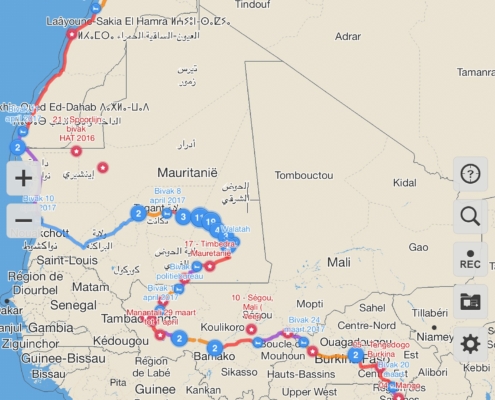


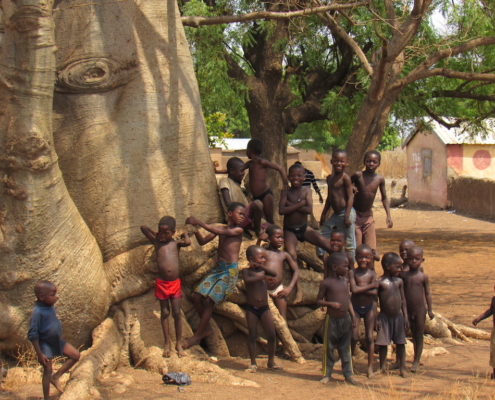
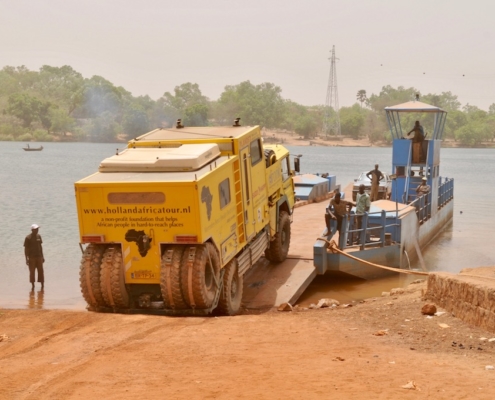

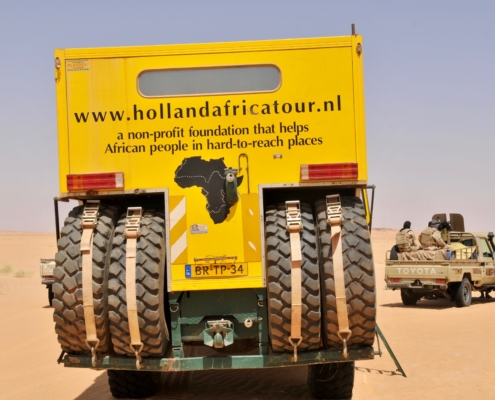
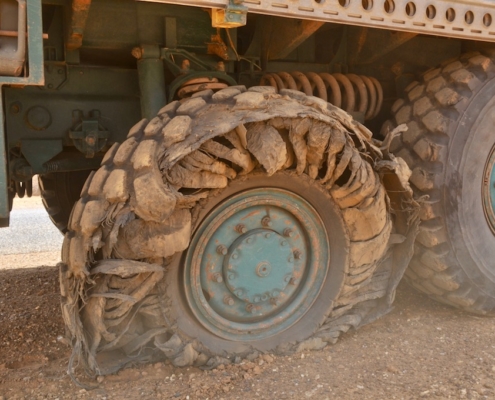

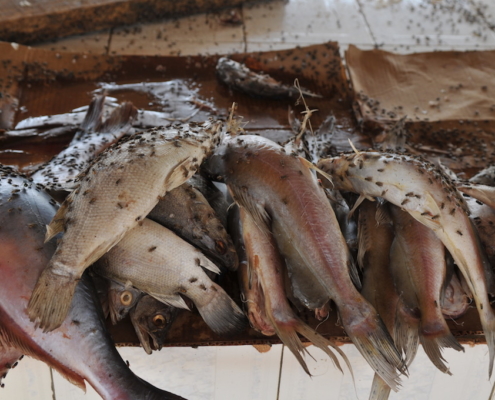


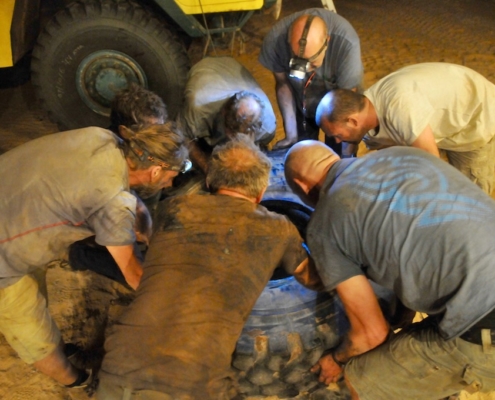
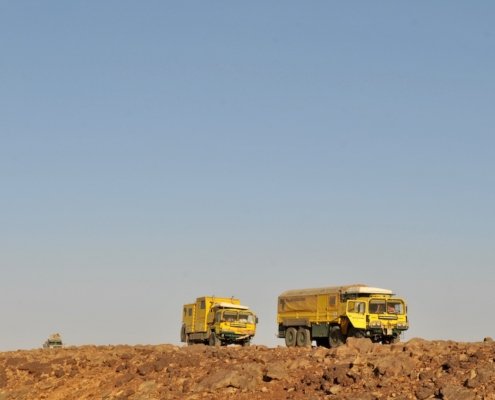
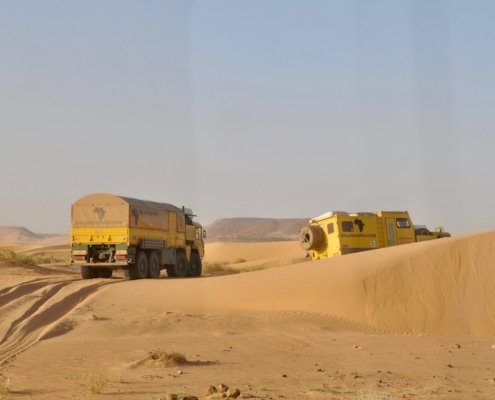
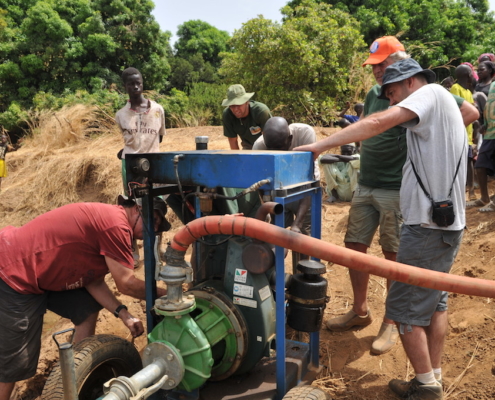
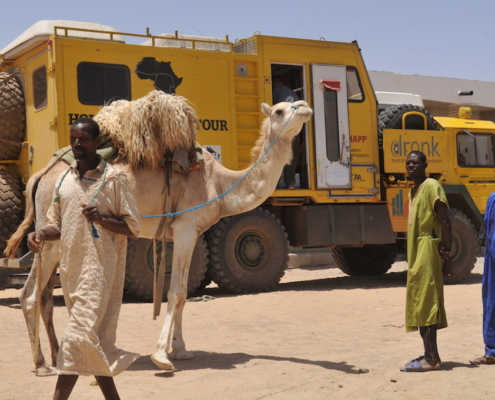



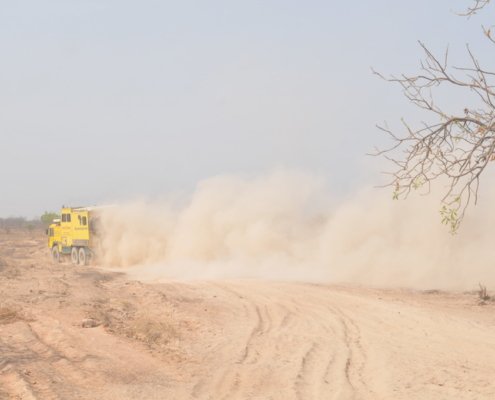

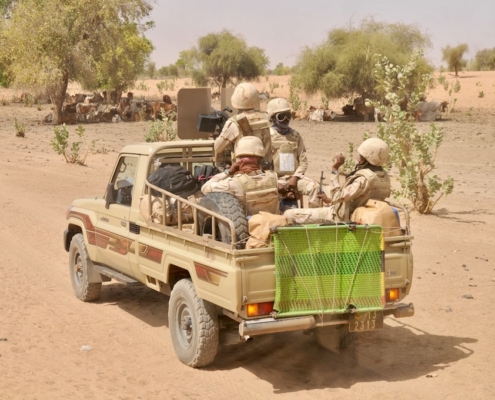
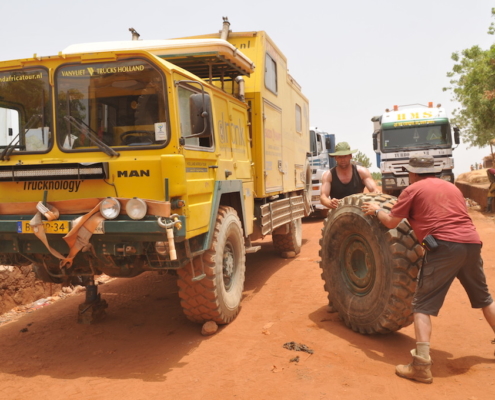
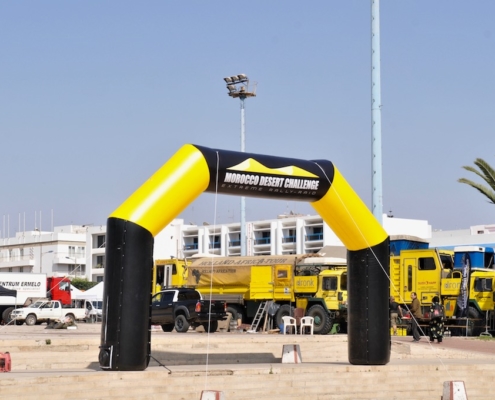
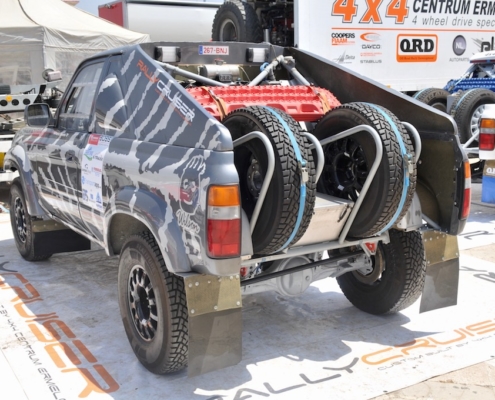


Leave a comment
Join the conversation?Feel free to contribute!